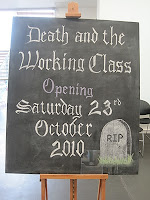The exhibition looks at how the working classes prepare for death, and it shows the rituals and traditions around it. During the 19th and early 20th century dealing with death was a common experience for normal people. It was not uncommon for children, especially babies, to die, and if a child survived infancy life expectancy was low for the working classes due to poverty and disease. In some communities half of all children were expected to die before their 5th birthday.
 |
| Coffin handles and shrouds |
Most people died at home and would be laid out there until the burial took place. This had the benefit of guarding the body from body snatchers. As a mark of respect curtains were drawn and clocks stopped, and friends, relatives and neighbours would pay their respects. It could be considered disrespectful if a neighbour didn’t ask to view a recently deceased person. In the exhibition there are recordings of people’s experiences, and an elderly lady recounts being taken to see a deceased child who was to be buried in a bridesmaid dress that she should have worn for a forthcoming wedding. This lady has never forgotten being taken to a neighbour’s house by her grandmother to see a woman and her newborn baby together in a coffin. She even remembers that they didn’t have wallpaper in the bedroom or carpets on the stairs.
The exhibition gives the details of several pit disasters, including the Pretoria Pit explosion in Atherton in 1910, which is the worst pit disaster in Lancashire where approximately 343 men and boys died, and the Cadeby Pit explosion in Yorkshire in 1912 which killed 74 men, half of them being members of the rescue team killed by a second explosion.
Unions played a part in ensuring its members received a respectable and respectful funeral. They would loan out drapes for the coffin and would also loan ‘widow’s weeds’ – the traditional mourning dress for widows. Chairs and crockery would be routinely borrowed from neighbours and companies would hire ‘funeral urns’, tea urns to be used at the wake. You can even try on different types of mourning attire.
 |
| Funeral tea urn, that would be hored out for a wake. |
During the opening day a 1933 Austin hearse and a horse drawn hearse were on display. The Co-operative Brass Band from Crewe plated (the exhibition is sponsored by The Cooperative Funeralcare), and the highlight was the coffin making demonstration, given by the Co-operative Funeralcare Coffin Factory in Glasgow.
 |
| Coffin making demonstration |
The company make 400 coffins a day (100,000 a year, weekdays only), all made to order, and are the largest manufacturer in the UK. To start off, the head end is attached to the sides with glue and a staple gun. The ‘bottom’ is then stuck/stapled onto the top (so they work on it upside down) and the sides attached. I had never thought about it before, but coffin sides curve, as the shoulders are the widest part and it tapers down to the feet. ‘Curves’ are put at shoulder level. These are slits that go almost all the way through the wood to weaken it, so that it can be bent around. The coffins then go to the assembly shop, where the holes from the staples are filled, imperfections sorted out and it is hand-sanded. It then goes to another part of the factory where the lids, manufactured elsewhere, are married up. From here, the coffin goes to the polishing shop, and then handles are put on. There are 5 standard sizes of coffin, up to 6’5’’, and they always go by person size, not coffin size, as the thickness of wood would give a false measurement of the inside. The factory has made a 3’ wide coffin in the last week, for a 50 stone man, and they get special requests daily as people often want to personalise their coffin. They use a company that ‘wrap’ the coffin in whatever colours the buyer wants, or a design can be put on. You can even have a photograph adapted to go around the coffin.
 |
| Undertaking was often a sideline to joinery |

Very interesting, I knew I should have gone with you!
ReplyDeleteFascinating!
ReplyDelete